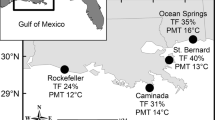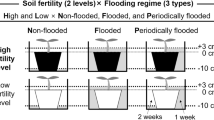Abstract
Cogongrass (Imperata cylindrica), an invasive perennial introduced from Southeast Asia, is currently spreading throughout the southeastern United States from Florida to Louisiana. In the U.S., cogongrass is generally not considered a wetland species, although it’s range is expanding in regions with high wetland abundance. The objective of this study was to determine if excessive soil moisture might prevent cogongrass from establishing in areas with seasonaly flooded soils. In one greenhouse experiment, we examined cogongrass germination and seedling growth in soils that were freely drained, saturated, and inundated. We performed a second greenhouse experiment to evaluate growth and survival of cogongrass seedlings of four different size classes in five soil moisture treatments ranging from dry to inundated. Cogongrass germination was lowest when seeds were overtopped with water. There were no differences in germination between saturated and freely drained treatments; however, seedlings grew larget in freely drained soil and were smallest when immersed. In our second experiment, most cogongrass plantswsurvived except when given no water, but growth differed by watering treatment depending on seedling size. Increasing moisture was more detrimental to the growth of small seedlings compared to the growth of larger cogongrass plants. Overall, cogongrass was most sensitive to soil inundation in the earliest stages of establishment; thus, excessive moisture conditions in the spring, during early seedling development, could restrict invasion of cogongrass by seed. Once cogongrass is established, however, it tolerance of flooding appears to increase.
Similar content being viewed by others
Literature cited
Bazzaz, F. A. 1991. Habitat selection in plants. TheAmerican Naturalist 137(Supplement): 116–130.
Blom, C. W. P. M., G. M. Bögemann, P. Laan, A. J. M. van der Sman, H. M. van der Steeg, and L. A. C. J. Vosesenek. 1990. Adaptations to flooding in plants from river areas. Aquatic Botany 38:29–47.
Brook, R. M. 1989. Review of literatur on Imperata cylindrica (L.) Raeuschel with particular reference to South East Asia. Tropical Pest Management 35:12–25.
Day, R. W. and G. P. Quinn. 1989. Comparisons of treatments after an analysis of variance in ecology. Ecological Monographs 59: 433–463.
Dickens, R. and G. M. Moore. 1974. Effects of light, temperature, KNO3, and storage on germination of cogongrass. Journal of Agronomy 66:187–188.
Ernst, W. H. O. 1990. Ecophysiology of plants in waterlogged and flooded environments. Aquatic Botany 38:73–90.
Fowler, N. L. 1988. What is a safe site?: neighbor, litter, germination date, and patch effects. Ecology 69:947–961.
Frasier, G. W., J. R. Cox, and D. A. Woolhiser. 1987. Wet-dry cycle effects on warm-season grass seedling establishment. Journal of Range Management 40:2–6.
Gerry, A. K. and S. D. Wilson. 1995. The influence of initial size on the competitive responses of six plant species. Ecology 76: 272–279.
Goldberg, D. E. 1987. Seedling colonization of experimental gaps in two old-field communities. Bulletin of the Torrey Botanical Club 114:139–148.
Grace, J. B. 1985. Juvenile vs. adult competitive abilities in plants size-dependence in cattails (Typha). Ecology 66:1630–1638.
Grubb, P. J. 1977. The maintenance of species-richness in plant communities: the importance of the regeneration niche. Biological Review 52:107–145.
Harper, J. L. 1977. Population Biology of Plants. Academic Press Inc., San Diego, CA, USA.
Hartgerink, A. P. and F. A. Bazzaz. 1984. Seedling-scale environmental heterogeneity influences individual fitness and population structure. Ecology 65:198–206.
Hitchcock, A. S. 1971. Manual of the Grasses of the United States. 2nd ed. Vol. 2. Dover Publications, Inc., New York, NY, USA.
Holm, L. G., D. L. Plucknett, J. V. Pancho, and J. P. Herberger (eds.). 1977. The World’s Worst Weeds: Distribution and Biology. University Press of Hawaii, Honolulu, HI, USA.
Keddy, P. A. and T. H. Ellis. 1985. Seedling recruitment of 11 wetland species along a water level gradient: shared or distinct responses. Canadian Journal of Botany 63:1876–1879.
King, S. E. 1999. Factors influencing the invasion of cogongrass (Imperata cylindrica (L.) Beauv.) in wet pine savanna communities. M.S. Thesis. University of Louisiana, Lafayette, LA, USA.
Kirkman, L. K. and R. R. Sharitz. 1993. Growth in controlled water regimes of three grasses common in freshwater wetlands of the southeastern USA. Aquatic Botany 44:345–359.
Klink, C. A. 1996. Germination and seedling establishment of two native and one invading African grass species in the Brazilian cerrado. Journal of Tropical Ecology 12:139–147.
Lippincott, C. L. 1997. Ecological consequences of Imperata cylindrica (cogongrass) invasion in Florida sandhill. Ph.D. Dissertation. University of Florida, Gainesville, FL, USA.
MacDonald, S. K. and I. E. Chandler. 1994. Element stewardship abstract for Imperata cylindrica cf. var. major. Nature Conservancy, Arlington, VA, USA.
Mack, R. N. and D. A. Pyke. 1984. The demography of Bromus tectorum: the role of microclimate, grazing and disease. Journal of Ecology 72:731–748.
Newbery, D. McC. and E. I. Newman. 1978. Competition between grassland plants of different initial sizes. Oecologia 33:361–380.
Parrish, J. A. D. and F. A. Bazzaz. 1985. Ontogenetic niche shifts in old-field annuals. Ecology 66:1296–1302.
Pickett, S. T. A. and F. A. Bazzaz. 1978. Germination of co-occurring annual species on a soil moisture gradient. Bulletin of the Torrey Botanical Club 105:312–316.
Potvin, M. A. 1993. Establishment of native grass seedlings along a topographic/moisture gradient the Nebraska sandhills. American Midland Naturalist 130:248–261.
Sajise, P. E. 1972. Evaluation of cogon (Imperata cylindrica (L.) Beauv.) as a seral stage in Philippine vegetational succession: I. The cogonal seral stage and plant succession. II. Autecological studies on cogon. Ph.D. Dissertation. Cornell University, Ithaca, NY, USA.
SAS Institute, Inc. 1989. SAS/STAT User’s Guide, Version 6, Fourth Edition, SAS Institute Inc., Cary, NC, USA.
Scheiner, S. M. and J. Gurevitch (eds.). 1993. Design and Analysis of Ecological Experiments. Chapman and Hall, New York, NY, USA.
Shilling, D. G., T. A. Bewick, J. F. Gaffney, S. K. McDonald, C. A. Chase, and E. R. R. L. Johnson. 1997. Ecology, physiology, and management of cogongrass (Imperata cylindrica). Final report prepared for the Florida Institute of Phosphate Research. Bartow, FL, USA.
Shupp, E. W. 1995. Seed-seedling conflicts, habitat choice, and patterns of plant recruitment. American Journal of Botany 82:399–409.
Tabor, P. 1949. Cogon grass, Imperata cylindrica (L.) Beauv. in the southeastern United States. Agronomy Journal 41:270.
Tabor, P. 1952. Cogon grass in Mobile County, Alabama. Agronomy Journal 44:50.
Teutsch, C. D., and R. M. Sulc. 1997. Influence of seedling growth stage on flooding injury in alfalfa. Agronomy Journal 89:970–975.
van der Valk, A. G. 1992. Establishment, colonization, and persistence. p. 60–92. In D. C. Glenn-Lewin, R. K. Peet, and T. T. Veblen (eds.) Plant Succession. Chapman and Hall, New York, NY, USA.
Voesenek, L. A. C. J., F. J. M. M. Van Oorschot, A. J. M. Smits, and C. W. P. M. Blom. 1993. The role of flooding resistance in the establishment of Rumex seedlings in river flood plains. Functional Ecology 7:105–114.
Wilcut, J. W., R. R. Dute, B. Truelove, and D. E. Davis. 1988. Factors limiting the distribution of cogongrass, Imperata cylindrica, and torpedo grass, Panicum repens. Weed Science 36:577–582.
Zar, J. H. 1984. Biostatistical Analysis. Second edition. Prentice Hall, Inc., Englewood Cliffs, NJ, USA.
Author information
Authors and Affiliations
Rights and permissions
About this article
Cite this article
King, S.E., Grace, J.B. The effects of soil flooding on the establishment of cogongrass (Imperata cylindrica), a nonindigenous invader of the Southeastern United States. Wetlands 20, 300–306 (2000). https://doi.org/10.1672/0277-5212(2000)020[0300:TEOSFO]2.0.CO;2
Received:
Revised:
Accepted:
Issue Date:
DOI: https://doi.org/10.1672/0277-5212(2000)020[0300:TEOSFO]2.0.CO;2




